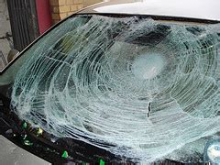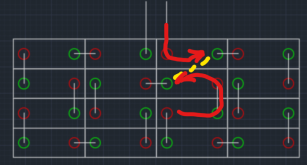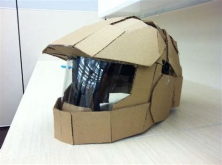The way I built my compression frame, it extends well above the height of the terminals. Anything I place over the batteries will rest on the frame, not the terminals/cables/lugs.
You are using an out of date browser. It may not display this or other websites correctly.
You should upgrade or use an alternative browser.
You should upgrade or use an alternative browser.
LiFePO4 prismatic cell short circuit current and main circuit protection
- Thread starter sduser
- Start date
I am thinking the alternate layout is much more likely to have a major short.
View attachment 40068
I'd just run the two bundles in the alt layout of sense wires inside some fireproof loom. That way it prevents the ability to scuff to the terminals and if they do short/overload some other way it's contained and will certainly become an open circuit in the loom.
Also not mentioned here but always best practice to keep the sense wires all the same length!
ArthurEld
Solar Wizard
I'm thinking about switching to the original layout. It seems safer to me.
And it will be easier to make a flip open cover
And it will be easier to make a flip open cover
John Frum
Tell me your problems
- Joined
- Nov 30, 2019
- Messages
- 15,233
If you don't mind my asking, why do you feel its safer?I'm thinking about switching to the original layout. It seems safer to me.
And it will be easier to make a flip open cover
Is there something specific that you are avoiding?
ArthurEld
Solar Wizard
If I short the original configuration less cells are involved. It's almost impossible to short all cells on the original layout.If you don't mind my asking, why do you feel its safer?
Is there something specific that you are avoiding?
But the alternate layout has the + and - right next to each other. And you can easily short a bunch of cells all down the middle of the battery.
pablo fiasco
New Member
- Joined
- Dec 30, 2020
- Messages
- 63
I'm going to do a little table top research. Someone mentioned that electric wire insulation burns. I found that counter intuitive so I tried and indeed it does. So long as there is a flame it burns. Remove the flame and it goes out. Same with the insulators on terminal crimps. 2 types of heat shrink I've tried so far went on burning without an external flame. I'm gathering up every kind of material I can find around the homestead and will post results eventually. Meanwhile anyone heard of Starlite? Or intumescent paint? There's some far out materials I want to try set fire to.Don't put plywood or cardboard over the batteries. I have to go out and remove mine.

Fire!! Never cover LiFePO4 with wood!!!
New adventure.. I went inside the battery room. As the exhaust fans where working, and they are temp based, I felt OK to close the door. I used wood (MDF) to cover the cells and sit on top, and to prevent accident if something falls 2 left over pieces, 10mm, but strong enough to sit on, as...diysolarforum.com
Last edited:
I think that's what is meant by "self-extinguishing" vs "non-flammable"?I'm going to do a little table top research. Someone mentioned that electric wire insulation burns. I found that counter intuitive so I tried and indeed it does. So long as there is a flame it burns. Remove the flame and it goes out. Same with the insulators on terminal crimps. 2 types of heat shrink I've tried so far went on burning without an external flame. I'm gathering up every kind of material I can find around the homestead and will post results eventually. Meanwhile anyone heard of Starlite? Or intumescent paint? There's some far out materials I want to try set fire to.
ArthurEld
Solar Wizard
I wonder about the plastic cover on these fuse holders - https://www.bluesea.com/products/5007100/Class_T_Fuse_Block_with_Insulating_Cover_-_110_to_200A
It says-
It says-
- Insulating cover satisfies ABYC/USCG insulation requirements
- UL 94-V0 base resists high heat
Hedges
I See Electromagnetic Fields!
- Joined
- Mar 28, 2020
- Messages
- 21,071
Never worn a helmet and I have cycle toured Europe. Only wear a seat belt when I think there might be a cop in the bushes.
I've never met anyone who had been killed by not wearing a seatbelt.
But I have seen many cars with punched windshields.
Similar for helmets; one of mine has some nice circular patterns in the paint.

pablo fiasco
New Member
- Joined
- Dec 30, 2020
- Messages
- 63
It's interesting to think things through. Not so interesting to let Google do it for you. I sometimes get diametrically opposite answers. Anyway, one does ones best and then lets go. If you want your boomerang to come back first you have to throw it.I wonder about the plastic cover on these fuse holders - https://www.bluesea.com/products/5007100/Class_T_Fuse_Block_with_Insulating_Cover_-_110_to_200A
It says-
Eventually I'll break off a piece and try to light it on fire
- Insulating cover satisfies ABYC/USCG insulation requirements
- UL 94-V0 base resists high heat
ArthurEld
Solar Wizard
There is another thing I am trying to avoid. Arcs.If you don't mind my asking, why do you feel its safer?
Is there something specific that you are avoiding?
I think there is less arc potential across the battery when the cells are lined up in 1P series
ArthurEld
Solar Wizard
This is a crappy representation of the bad short I had. The yellow line shows where my tool shorted.
The red is showing the current path changing directions and moving toward each other. I think that makes a difference.
The two current paths are already trying to reach each other which causes more arc potential right there. And that aided my tool keeping the sort connection even though it fell away from the terminal.
I have no proof but I think this makes a difference.

When there's more arc potential a short is more eager to happen. I don't want that.
The red is showing the current path changing directions and moving toward each other. I think that makes a difference.
The two current paths are already trying to reach each other which causes more arc potential right there. And that aided my tool keeping the sort connection even though it fell away from the terminal.
I have no proof but I think this makes a difference.

When there's more arc potential a short is more eager to happen. I don't want that.
pablo fiasco
New Member
- Joined
- Dec 30, 2020
- Messages
- 63
I've been down a dozen times. One time over the bars down a flight of stairs on a mountain bike. My feeling is that what you can't risk losing is not worth having. Just me setting a bad example. Not giving advice.I've never met anyone who had been killed by not wearing a seatbelt.
But I have seen many cars with punched windshields.
Similar for helmets; one of mine has some nice circular patterns in the paint.
View attachment 40144
ArthurEld
Solar Wizard
I got knocked off a motorcycle going 70 mph. If I didn't have on a cheap novelty helmet I'd have a flat spot worn into my scull just like the one on the helmet.
pablo fiasco
New Member
- Joined
- Dec 30, 2020
- Messages
- 63
Not DOT or SNELL? Say it weren't so.I got knocked off a motorcycle going 70 mph. If I didn't have on a cheap novelty helmet I'd have a flat spot worn into my scull just like the one on the helmet.
ArthurEld
Solar Wizard
I think I did stick a DOT sticker on it. We're way off topicNot DOT or SNELL? Say it weren't so.
pablo fiasco
New Member
- Joined
- Dec 30, 2020
- Messages
- 63
Yep. Become DIY philosophy. Let's try to focus. (Largely my fault I think. Sorry.)I think I did stick a DOT sticker on it. We're way off topic
I know I'm a bit late to join this discussion, but am hoping for a sanity check on a fuse I want to use.
I need a fuse that is somewhere between my max load of about 130A and the max current rating of my cables, 188A. It could potentially see the full force of a 450Ah 8s LiFePO4, so I think I want a high interrupt rating. Class T fuses below 225A are a real hassle to obtain in Australia, and expensive.
My reading of the specifications seems to indicate this NH fuse will work. I'm a bit unclear whether the "Rated breaking capacity: 120kA" on page 1 of the data sheet applies to DC or just AC. Details for the 160A version are on page 3.
Product page link
Data sheet
I'd really appreciate if anyone can help me decipher the data sheet.
I need a fuse that is somewhere between my max load of about 130A and the max current rating of my cables, 188A. It could potentially see the full force of a 450Ah 8s LiFePO4, so I think I want a high interrupt rating. Class T fuses below 225A are a real hassle to obtain in Australia, and expensive.
My reading of the specifications seems to indicate this NH fuse will work. I'm a bit unclear whether the "Rated breaking capacity: 120kA" on page 1 of the data sheet applies to DC or just AC. Details for the 160A version are on page 3.
Product page link
Data sheet
I'd really appreciate if anyone can help me decipher the data sheet.
There's insufficient information. It's rated to 250Vdc but you're right -- the breaking capacity isn't qualified with AC or DC. It looks like it's mostly designed for an AC circuit so I personally wouldn't choose it.I know I'm a bit late to join this discussion, but am hoping for a sanity check on a fuse I want to use.
I need a fuse that is somewhere between my max load of about 130A and the max current rating of my cables, 188A. It could potentially see the full force of a 450Ah 8s LiFePO4, so I think I want a high interrupt rating. Class T fuses below 225A are a real hassle to obtain in Australia, and expensive.
My reading of the specifications seems to indicate this NH fuse will work. I'm a bit unclear whether the "Rated breaking capacity: 120kA" on page 1 of the data sheet applies to DC or just AC. Details for the 160A version are on page 3.
Product page link
Data sheet
I'd really appreciate if anyone can help me decipher the data sheet.
Class T fuses are expensive ... that's part of why I moved to a quality DC breaker. Maybe you'll have more luck sourcing a breaker?
Similar threads
- Replies
- 13
- Views
- 820
- Replies
- 0
- Views
- 348
- Replies
- 1
- Views
- 171
- Replies
- 0
- Views
- 49



